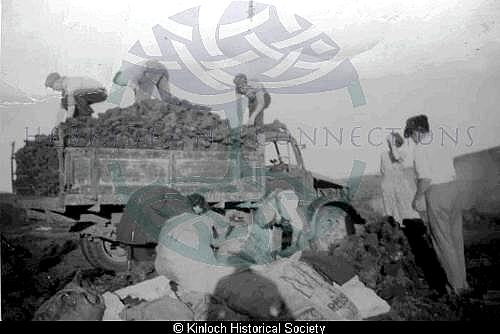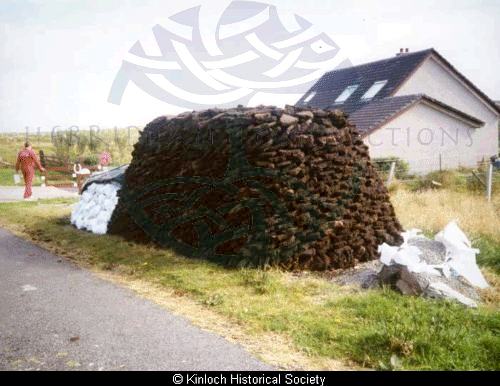38129: The Dying Art of Peat Cutting
Peat cutting is a dying art that Hector Macaulay who is 92 years old and lives in the village of Balallan on Lewis remembers well.
When I was young peat was our only means of fuel for heating and cooking. We had an open fire in the middle of the floor that had a brick on either side of it to keep the fire in. Above this was a piece of wire for pots.
To get to the stage of cooking and heating with peat was no easy task though, as Hector remembers
When Spring came it was time to cut the peats. Every family in the village had peat banks in the moor to cut. We would help each other with the hard work. Straight after a breakfast of porridge we would set off en masse. All the women would carry a creel on their back loaded with food for the day and pots with which to cook. The men would carry the tairsgear or peat iron and spades.
It wasn’t unknown for children to miss school for the great event of buin na monadh. Indeed it is noted on certain school registers for the turn of the last century that school children were absent because they were cutting the peats! Hector continues:
We would be out cutting the peats all day . At midday we would stop for a dinner break that the woman would have prepared. A great fire would be lit and salt fish and potatoes would be ready for us. It was straight back to work after that until 4 o’clock when we would sit down for a cup of tea.
One person would cut the peat and the other would throw it. Bearing in mind that each peat could weigh up to 8kg in weight it wasn’t a job for the faint hearted. Age wasn’t an issue either, it was fitness levels that mattered ,
I remember one old man and his wife out cutting the peats and the woman was up to her knees in the mud and water. She had taken off her shoes and socks so as not to ruin them. The people didn’t have much then but they were far happier
Cutting peats also meant a time of socialising. Crowds of people would gather to cut the peats of those who were infirm.
We were all helping an old woman cut her peats who was living on her own and had no family. A visitor who was home on holiday took his bagpipes out to the moor. We had a wonderful day, cutting the peats and dancing to the tunes of the pipes in between. You never saw anything like it in your life; you could hear the shouting and the laughing for miles about. The young of today wouldn’t know what foot to put onto the spade!
After a few weeks of dry weather the peats were gathered and taken home by lorry. Hectors eyes sadden a little:
Losing the old traditions has had a terrible effect on the people. Money is so plentiful nowadays. If you were to ask a young person he’d say ‘It’s a fool that works’
Hector showed me a small but perfectly formed peat stack at the back of his byre. When asked who cut them for him, he looked at me with astonishment.
Myself, of course. I cut them last year. They don’t call me the boy for nothing you know!
Kinloch Historical Society
Details
- Record Type:
- Story, Report or Tradition
- Type Of Story Report Tradition:
- Interview
- Record Maintained by:
- CECL

